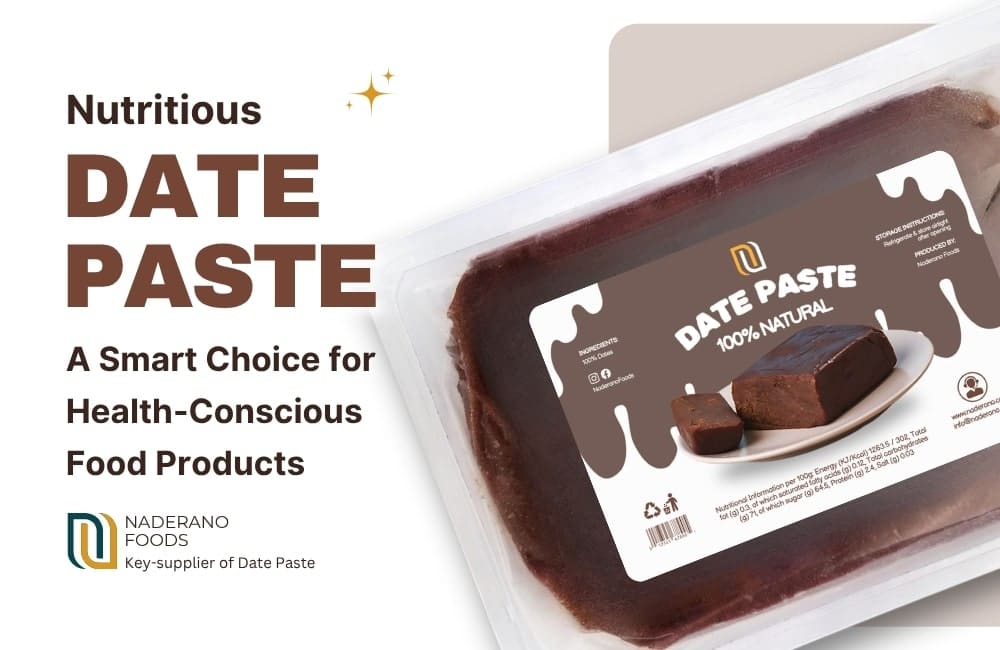In today’s health-conscious food industry, nutritious date paste is emerging as a smart choice for forward-thinking product developers. Brands are under pressure to formulate clean-label, functional foods and implement sugar reduction strategies to meet consumer demand in 2024–2025. Natural sweeteners that provide more than empty calories are on the rise. Naderano Foods, a B2B exporter and supplier of date paste, has observed a surge of interest from food manufacturers looking to replace refined sugars with fruit-based alternatives. With shoppers seeking better-for-you products, date paste offers the appealing combination of natural sweetness and genuine nutritional value.
One major driver of this trend is the push to curb added sugar intake. According to the World Health Organization, nearly half of global consumers are actively trying to cut down on sugar, fueling demand for nutrient-rich substitutes like date syrup and date paste. The clean-eating movement means manufacturers are searching for sweet ingredients that add nutrition rather than just calories. Industry observers have taken note as well – Whole Foods Market even named dates the “Great Date” in its Top 10 Food Trends, noting that dates are “having a major renaissance as a sweetener” in forms like pastes and syrups, showing up in everything from ketchup to overnight oats. In this landscape, using date paste can help food companies stay ahead of consumer expectations while improving the nutritional profile of their products.
Key Nutrients in Date Paste: Fiber, Minerals and More
Date paste isn’t just another sweetener – it’s a nutritional powerhouse derived entirely from whole fruit. Because it is made by grinding whole pitted dates, it retains the beneficial nutrients of the fruit that refined sweeteners lack. Notably, date paste is rich in dietary fiber, which supports digestive health and moderates blood sugar release. A typical 100-gram serving of dates provides about 7 grams of fiber (roughly 25% of daily needs) along with an array of vitamins and minerals. Dates are particularly high in potassium (around 15–23% of Daily Value per 100g) and provide useful amounts of magnesium, iron, and vitamin B6. All of these micronutrients remain present when dates are made into paste, meaning manufacturers can deliver a small boost of essential minerals with every spoonful of date paste used.
Another standout feature is the antioxidant content of dates and date paste. Unlike refined sugar, which offers no antioxidants, date paste contains beneficial plant compounds (like flavonoids and carotenoids) that help combat oxidative stress in the body. These antioxidants contribute to the “functional food” aspect of date paste – they have been linked to reduced inflammation and a lower risk of chronic diseases when included as part of a balanced diet. In essence, using date paste allows product developers to sweeten recipes while also adding fiber and natural phytonutrients. It transforms sweetness from being purely about taste to also contributing to the nutrition story of the product.
Nutritious Date Paste vs. Refined Sugar: Nutrients Over Empty Calories
Refined sugar (white crystals) versus date paste (dark brown puree). Unlike white sugar’s empty calories, date paste provides natural sweetness along with fiber and micronutrients.
When comparing nutritious date paste to traditional sweeteners like table sugar or glucose syrup, the differences are striking. Refined white sugar is essentially pure sucrose – an empty-calorie ingredient offering energy but zero fiber, vitamins, or minerals. High-fructose corn syrup and other processed sugars are similar, providing sweetness without any accompanying nutrients. Date paste, by contrast, is made from 100% fruit with minimal processing. A reliable date paste manufacturer ensures the paste is produced hygienically, with consistent texture and Brix levels for industrial use. It is simply whole dates pureed into a smooth paste, so all the intrinsic goodness of the fruit remains intact. This means date paste delivers natural sugars along with dietary fiber and micronutrients – effectively turning a one-dimensional sweetener into a more wholesome ingredient.
From a nutritional standpoint, date paste far outshines refined sugar. White sugar contains 0% fiber and no meaningful nutrients – it’s 100% carbohydrate with nothing beneficial accompanying the calories. In contrast, date paste contributes a useful amount of fiber that aids digestion and slows the absorption of sugars. It also adds small but noteworthy levels of minerals like potassium, magnesium, and iron that simply do not exist in cane sugar. In practical terms, replacing refined sugar with date paste turns an empty-calorie component into one that enriches a recipe with extra nutrients.
There’s also a difference in how these sweeteners affect blood sugar. Refined sugars rank high on the glycemic index and can cause rapid spikes in blood glucose, followed by the notorious crash soon after. Date paste has a gentler glycemic impact thanks to its fiber and complex carbohydrates, which slow down the release of sugars into the bloodstream. Foods sweetened with date paste lead to a steadier rise and fall in blood glucose, helping to avoid the rollercoaster energy spikes and dips that come from using plain sugar. For product developers, this can be a selling point – e.g. a breakfast bar made with date paste can promise “no sugar crash” and sustained energy. While date paste does contain natural sugars and isn’t calorie-free, it delivers sweetness with far fewer negative metabolic effects compared to refined sugar. In short, nutritious date paste provides a sweet taste along with dietary benefits, whereas refined sugar provides only sweetness and calories.
Why Food Manufacturers Are Embracing Date Paste
With its impressive nutrient profile and consumer-friendly image, date paste has quickly become a go-to ingredient for many health-focused food manufacturers. It offers multiple advantages in product development, beyond just nutrition. For one, date paste aligns perfectly with the clean label trend. It appears on ingredient lists as a single, recognizable item – often just “dates” or “date paste” – which reassures shoppers looking for natural, unprocessed contents.
This simplicity enables attractive claims like “no refined sugar” or “sweetened with fruit,” which are powerful marketing points for modern better-for-you brands. Crucially, those claims are backed by substance: by formulating with date paste, companies can legitimately avoid adding refined sugar or artificial sweeteners. Even in smaller amounts, date paste contributes fiber and nutrients (like potassium) to the recipe, providing an added nutrition angle that empty sugars cannot match. And because date paste is literally a fruit product, many consumers perceive it as a more wholesome source of sweetness.
Manufacturers are also drawn to date paste for its functional benefits in recipes. This ingredient brings a rich, caramel-like flavor and moist texture that can improve the overall quality of foods. Unlike white sugar, which just dissolves and sweetens, date paste can enhance mouthfeel and act as a natural binder.
For example, in baked goods, date paste not only sweetens but also helps products stay moist and soft thanks to its fruit solids. In fact, many bakers find that using date paste yields cakes and muffins that remain fresher for longer, with a pleasant hint of caramel sweetness. Similarly, in snack bars and cereals, date paste serves as both a sweetener and a binding agent. It can hold together oats, nuts, and seeds in granola or protein bars, eliminating the need for corn syrup or additional binders. Some well-known brands proudly advertise that their bars are “sweetened only with dates,” leveraging the appeal of fruit-based ingredients to win health-conscious consumers. By using date paste, R&D teams can often simplify formulations (fewer additives needed) while improving flavor and texture – truly a win-win for product development.
Bakery and Confectionery Applications
Date paste has proven especially popular in the bakery and confectionery sector as a replacement for refined sugar. It can be used in breads, muffins, cookies, and cakes to partially or fully substitute white sugar. Bakers appreciate that date paste provides natural sweetness and a touch of caramel flavor that pairs well with whole grains, spices, and cocoa. Importantly, the moisture content of date paste helps keep baked goods soft and prevents drying out.
For instance, a cookie recipe using date paste may stay chewier compared to one made with sugar, since the date paste holds moisture. Confectionery products like energy balls or chocolate truffles also benefit – date paste can bind together nuts and other ingredients, acting as a one-stop sweetener + binder with no need for corn syrups. This not only improves the nutritional profile of the treat but also appeals to clean-label expectations. In short, from artisan bakeries to large-scale commercial bakeries, date paste is being adopted to create better-for-you indulgences that don’t sacrifice taste or texture.
Snack Bars and Cereal Products
Health and snack bars, granolas, and breakfast cereals are another area where industrial date paste shines. Many brands in the nutrition bar category use date paste as a foundational ingredient – it provides the sweetness to replace refined sugars and the stickiness to hold bar components together.
A typical fruit and nut bar might rely on date paste to bind oats, almonds, and seeds into a cohesive bar without any added syrups. The result is a bar with no refined sugar and only fruit-derived sugars, often allowing for claims like “contains only fruit sugars” or “no sugar added” (since the sweetness comes from whole fruit). Cereal clusters and granolas can similarly use date paste in place of brown sugar or honey.
Beyond the formulation benefits, using date paste in these products gives a marketing boost: consumers equate dates with natural energy and fiber, making the product feel more wholesome. Given the popularity of on-the-go healthy snacks and breakfast alternatives, it’s no surprise that date paste has become a key ingredient for innovation in this space. Brands targeting athletes, busy professionals, or parents can highlight the fact that their snacks are sweetened with nutrient-rich date paste instead of corn syrup or refined sugar, reinforcing the product’s better-for-you positioning.
Baby Foods and No-Added-Sugar Snacks
In the baby food and toddler snack category, the use of date paste has grown rapidly due to heightened scrutiny on added sugars for young children. Pediatric nutrition guidelines – and parents themselves – increasingly recommend avoiding refined sugar in foods for infants and toddlers. Date paste offers a gentle, all-natural sweetness that helps make products palatable for little ones without any refined sugar.
For example, an infant fruit puree or applesauce might include a touch of date paste to enhance sweetness instead of cane sugar. Likewise, toddler biscuits, teething rusks, or fruit snacks can be sweetened with date paste to meet “no added sugar” label claims (since the sweetness is derived from fruit). This is a significant selling point in the baby aisle – parents are looking for labels that say no sugar added, and using date paste allows manufacturers to achieve that while still delivering a pleasant taste.
Additionally, the nutritional aspects of dates (fiber, potassium, etc.) align with the goals of early nutrition, albeit in small amounts. Overall, date paste enables baby and kids’ food producers to create naturally sweet products that satisfy taste expectations and stringent nutrition criteria simultaneously. From purees to snack bars for kids, fruit-based sweetening with dates has become an industry best practice for companies aiming to support healthier diets from an early age.
Supporting Clean Labels and Nutrition Claims
Beyond its technical uses, date paste helps manufacturers navigate evolving consumer expectations, regulatory guidelines, and nutrition claims. Modern shoppers are looking for “clean labels” – short, recognizable ingredient lists with nothing artificial. Date paste fits this perfectly: it can often be listed simply as “dates” (if it’s 100% date content), which looks far more appealing than “sugar” or chemical sweetener names. This simplicity builds trust, signaling that the product is made with whole-food ingredients.
In fact, seeing date paste on an ingredient label immediately tells a health-conscious consumer that the product is likely more wholesome and fruit-based. Manufacturers can capitalize on this by highlighting front-of-package claims such as “made with real fruit”, “no refined sugar”, or “naturally sweetened with dates.” Such phrases resonate strongly in categories like snacks, cereals, and baby foods, where buyers actively compare sugar content and ingredients. Using date paste makes it straightforward to back up these claims, since the product truly contains only fruit sugars rather than any refined sugar.
There are also regulatory considerations pushing companies toward ingredients like date paste. Around the world, governments have started implementing measures like sugar taxes, mandatory added sugar labeling, and nutrition standards aimed at reducing sugar consumption. Since 2023, these pressures have accelerated reformulation efforts – companies are looking to lower the total added sugars in their products to avoid penalties and to meet new labeling requirements.
Date paste can be an effective tool in sugar reduction strategies. For one, when date paste replaces refined sugar, the overall glycemic load of the product can be lower, and in some markets the naturally occurring sugars in fruit might not count as “added sugar” on the nutrition panel (this depends on local regulations, but often fruit ingredients are viewed differently than straight sugar). Even where fruit sugars do count as added sugar, the use of date paste can help reduce the total grams of sugar needed due to its intense sweetness and flavor.
Additionally, date paste’s contribution of fiber might improve a product’s nutritional rating or help it qualify for certain claims (for example, a “source of fiber” claim if the finished product contains enough fiber). Consumer expectations around nutrition claims are also met: a product that includes date paste might legitimately boast “contains fiber and potassium” or “made with nutrient-rich dates,” which can differentiate it from a competitor laden with corn syrup. All these factors make date paste not only a healthier ingredient choice but a strategic one for navigating the current regulatory and market landscape.
Conclusion: A Sweet Opportunity for Healthier Food Products
In summary, nutritious date paste has proven to be a smart choice for food manufacturers catering to today’s health-conscious and label-conscious consumers. This natural sweetener addresses multiple industry trends at once: it aligns with the clean-label movement by being a single-ingredient, recognizable sweetener, it contributes to the push for sugar reduction without sacrificing sweetness, and it adds functional nutrition (fiber, minerals, antioxidants) to products in a way refined sugar simply cannot.
From the R&D perspective, date paste empowers teams to create the next generation of better-for-you products that still deliver on taste and indulgence. Whether it’s boosting the fiber content of a breakfast bar or enabling a “no added sugar” claim on a new snack for kids, date paste opens up opportunities to innovate in line with 2024–2025’s top trends.
As consumers continue to seek out foods that are both delicious and nourishing, ingredients like date paste will play an increasingly important role. Forward-thinking brands in bakery, snacks, baby food, and beyond are already leveraging this fruit-based sweetener to differentiate their products and earn consumer trust. It’s a sweet solution that proves you don’t have to compromise between health and flavor.
If your company is looking to formulate healthier, more natural products, consider making the switch to date paste. Naderano Foods, as a leading B2B date paste supplier and exporter, is ready to support your innovation. Get in touch with us to request a sample or a quote, and discover how our high-quality date paste can elevate your next health-focused food product. We’re here to help you embrace the smart choice of date paste and create foods that delight customers and meet their nutritional expectations.
LEAVE US A MESSAGE ON WHATSAPP


